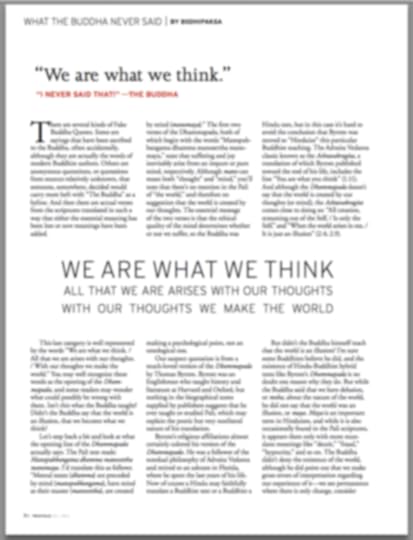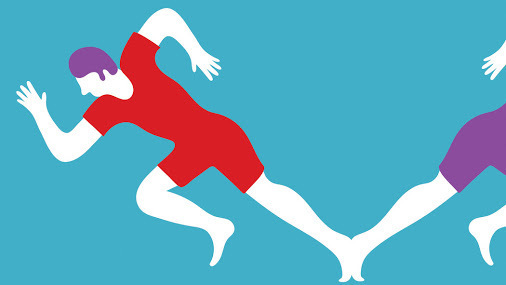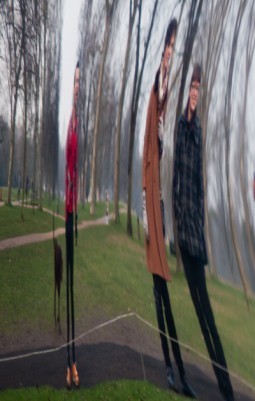Bodhipaksa's Blog, page 9
July 19, 2014
Coming soon to Tricycle

I have a new Fake Buddha Quote column in the Fall edition of Tricycle, which will soon be trundling into a bookstore near you.?
This post has been reshared 1 times on Google+
View this post on Google+
Related posts:
Tricycle on Buddhism and politics
Funny!
This is brilliant in so many ways…
Related posts brought to you by Yet Another Related Posts Plugin.
July 18, 2014
Getting the dead dog off of your shoulders
 What kinds of things do we get up to when we are meant to be meditating, but have become distracted? Most people will say they “think” or “fantasize,” but that’s not very specific. What kind of thinking is going on? What kinds of desires drive our fantasies?
What kinds of things do we get up to when we are meant to be meditating, but have become distracted? Most people will say they “think” or “fantasize,” but that’s not very specific. What kind of thinking is going on? What kinds of desires drive our fantasies?
There are five traditional hindrances to meditation. Speaking very non-technically, what we tend to do when we’re distracted is one of the following:
Getting annoyed about things we dislike
Fantasizing about things we like
Worrying and fidgeting
Snoozing and avoiding challenges
Undermining ourselves with stories about what we can’t do
These are the five hindrances in very non-technical language. Each of them is a form of mental turbulence that prevents us from experience the natural calmness and joy of the undisturbed mind.
The Buddha suggested a number of ways to calm the mind by dealing with the hindrances.One approach, which we could call “reflecting on the consequences,” uses thought to calm our thinking.
He suggested that we reflect on the disadvantages of continuing to be caught up in the hindrance that is currently dominating our minds. For example, we can ask, What will happen if I continue to let my mind be dominated by anger or doubt? Will it make me happy? Are the consequences of these mental states with those that I want to live with? By consciously reflecting in this way, we bring alternative visions of the future into our present consciousness. We thus create the possibility of choice. We are then able to experience an emotional response to each of the alternatives we’ve imagined.
So, if you imagine that continuing to indulge in angry states of mind is going to lead to isolation and conflict, then the emotional response to that imagined future outcome may well be one of aversion. And generating aversion to the outcomes of anger will tend to lead to aversion to the anger itself. (This is a useful aversion to have!) And we may imagine being calm, confident, and kind, and this exerts its own emotional pull, making it more likely that we’ll choose the path that leads us there.
The Buddha used a very colorful image to describe this antidote. He said it was “like a young woman or man, in the flush of youth and fond of finery, who would be ashamed to have the carcass of a dog or snake hanging round his neck.” I like this image. It reminds us there is beauty already present beneath the hindrance, and that the hindrance itself is something that mars our inherent spiritual loveliness, and that is relatively superficial and extraneous.
So, when you notice you’re in an unhelpful state of mind, see where that’s leading you by reflecting on the consequences. Become aware of the unwholesomeness of the negative mental state that you’re experiencing, and allow a natural and wholesome aversion towards it to emerge. But also be aware that there is an inner beauty just waiting to be revealed.
Related posts:
“Being in the moment”
Waking up from the hindrance of sloth and torpor
Words of equanimity; wordless equanimity (Day 84)
Related posts brought to you by Yet Another Related Posts Plugin.
July 17, 2014
Father and son

A portrait of me, by my son. The small bundle in my arms is him when he was a baby.?
This post has been reshared 2 times on Google+
View this post on Google+
Related posts:
Funny!
This is brilliant in so many ways…
Related posts brought to you by Yet Another Related Posts Plugin.
July 6, 2014
This is brilliant in so many ways…

This is brilliant in so many ways…
Reshared post from +Alan Will2
What would you do if you were God??
This post has been reshared 5 times on Google+
View this post on Google+
Related posts:
A herbal remedy for lifeache, from the brilliant Michael Leunig.
How fast can a picture spread on the internet?
Funny!
Related posts brought to you by Yet Another Related Posts Plugin.
July 4, 2014
The secret of effective motivation

The Secret of Effective Motivation
Encourage people to do something for its own sake, not for its benefits.
Related posts:
Fake Buddha Quote: “The secret of health for both mind and body is not to mourn for the past, worry about the future, or anticipate troubles, but to live in the present moment wisely and earnestly.”
The secret cause of flame wars…
The Dalai Lama’s secret death ray
Related posts brought to you by Yet Another Related Posts Plugin.
July 3, 2014
A lotus that blooms with your meditating mind?
 Rohan Dixit is a former neuroscience researcher who studied meditation and the brain at Harvard and Stanford University. He also spent a year measuring the brainwaves of meditating monks in the Himayalas, which is nice work if you can get it.
Rohan Dixit is a former neuroscience researcher who studied meditation and the brain at Harvard and Stanford University. He also spent a year measuring the brainwaves of meditating monks in the Himayalas, which is nice work if you can get it.
Rohan has a fascinating project that he’s Kickstarting at the moment. It’s called the Lotus and it’s essentially a hand-made brass flower that blooms with your mind.
The Lotus responds to your brainwaves through a supported brain-sensing headset, which is hooked up to a smartphone app. When the headset detects that you’re calm and relaxed, the flower blooms and begins cycling through colors.
The Lotus gradually closes and slowly changes colors when it’s time to meditate again. This is a nice visual reminder to take a mindful break during your day.
That’s nice, but there’s a really lovely feature, which is that you can connect friends to your Lotus. You can assign a particular color to a friend, and when he or she meditates your Lotus will respond and change to their color. I love that idea.
Another really cool thing is that the Lotus isn’t mass-produced by sweatshop workers in China. It’s hand-crafted by artisans in Uttar Pradesh and Maharashtra in India, forging petals by hand out of metal. As the Kickstarter page says, “Combined with cutting edge neurotechnology, biosensors, and 3D printed components, the Lotus is a blend of the very ancient and the highly modern.”
Some of the rewards are very nice, too, including a bunch of guided meditations for $5. I think the Lotus is an intriguing idea, and if you do as well, why not head over to Rohan’s Kickstarter page and make a donation.
Related posts:
A recent rainbow
When you’re afraid of meditating
Open mind: focused mind
Related posts brought to you by Yet Another Related Posts Plugin.
June 30, 2014
I'm no longer shopping at Target
Reshared post from +Susan Stone

Moms Group Told To Leave, Target Calls Them A ‘Distraction,’ Gun Toting Protesters Allowed
A San Antonio based Target store told protesters who were trying to bring awareness to the company’s national policy regarding the allowance of armed weapons into their stores, to leave. In contras…
Related posts:
My favorite email of the morning started like this:
Funny!
Bright fall leaves on a gray day…
Related posts brought to you by Yet Another Related Posts Plugin.
June 29, 2014
Clever: passwords that are also affirmations?

How a password changed my life.
The following events occurred between ? and ?.
This post has been reshared 2 times on Google+
View this post on Google+
Related posts:
Affirmations can make you feel worse
Funny!
This is brilliant in so many ways…
Related posts brought to you by Yet Another Related Posts Plugin.
June 14, 2014
For people who hate their bodies
 Not many people like their bodies. The typical reaction from looking at oneself naked in the mirror lies somewhere on a spectrum from mild disappointment to outright revulsion, with a bit of disbelief thrown in (how did I get so old? where did those wrinkles come from? where’s my hair gone?)
Not many people like their bodies. The typical reaction from looking at oneself naked in the mirror lies somewhere on a spectrum from mild disappointment to outright revulsion, with a bit of disbelief thrown in (how did I get so old? where did those wrinkles come from? where’s my hair gone?)
I had a little epiphany the other day, though. I’d been talking with my girlfriend, who I adore. She’s beautiful. Really beautiful. And she’s also afflicted by doubts about her attractiveness. So when we were talking she was going over some of the things she didn’t like about her appearance (wrinkles, etc) and I’m, like, “I don’t care. I love those things about you. You’re beautiful.” Well, you know what it’s like when you love someone unconditionally. There’s just a complete acceptance of the whole of them. So that’s one thing.
Then I walk into the bathroom to get ready for bed, and see myself naked in the mirror. And a quick series of criticisms of my body flashes through my mind. Some bits are too skinny. Some bits are too flabby, too hairy, not hairy enough… My overall response could be summed up in the word “Yuck.”
And then I caught myself. Why can’t I give myself the same uncritical love that I give to my girlfriend? I mean she thinks I’m attractive, so why can’t I just accept that?
So I started telling bits of my body that I love them. I patted my belly fondly and said “I love you.” I did the same as I touched my thinning scalp. And as I laid a hand on my man-boobs.
And you know something? It feels great saying those things. Criticizing ourselves is almost as painful as being criticized by others, but giving ourselves affection, appreciation, and acceptance is often even more moving than receiving those things from other people, because it’s something we so rarely do. So I’ve been doing this ever since. You might want to try it too.
If there’s an inner voice telling you that this is silly or doubting that you can really love those bits of yourself that you tend not to like, don’t suppress that voice or try to argue with it. Just let the thoughts come and go.
Bear in mind that this is something you might want to repeat often. After all, you might have criticized your body tens of thousands of times, so perhaps it’ll take you a while to get into the habit of doing the opposite. But do try it. I’d love to hear how you get on.
Related posts:
Why you don’t really hate yourself
I love Google+, but… In the last 6 days one of my articles has been visited by 19,264 people fr…
Not knowing how near the Truth is, people seek it far away
Related posts brought to you by Yet Another Related Posts Plugin.
June 13, 2014
Self compassion webinar
 Last month I was honored to be a guest of Leo Babauta of Zen Habits, who had asked me to talk about and to answer questions on self-compassion.
Last month I was honored to be a guest of Leo Babauta of Zen Habits, who had asked me to talk about and to answer questions on self-compassion.
It was supposed to be a video, but unfortunately my camera decided to stop talking to my computer just as the webinar began. But Leo kindly send me the audio of the conversation, and I invite you to listen to it below.
I discuss the practice of self-compassion in terms of a very useful Buddhist teaching extracted from the 12 nidanas (links) that illustrate dependent origination, or paticca-samuppada. These are (in a slightly adapted form):
Contact: the mind’s filtered and interpreted contact with the world
Feeling: the mind’s labeling of perceptions as pleasant, unpleasant, or neutral
Volition: our cognitive and emotional responses, indicating how we should act in response to those feelings
Action: our actual responses, created by the acting out of our volitions
As far as I recall I mainly discussed the first three of these as points where we can act to create a more compassionate response to ourselves.
I hope it’s beneficial to you. I’d love to hear what you think, and what your experience is.
Related posts:
Exploring Self Compassion: A retreat in Washington, Sep 26–29, 2013
Exploring Self Compassion: A retreat in Washington, Sep 26–29, 2013
The Urban Retreat, Day 8: Developing compassion
Related posts brought to you by Yet Another Related Posts Plugin.



